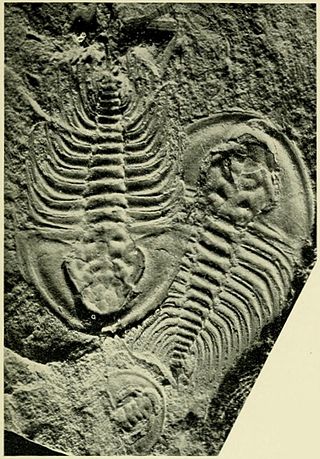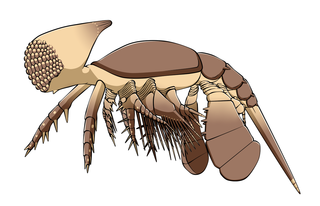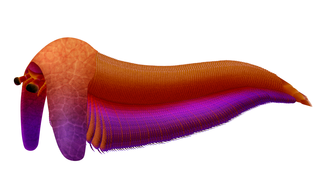
Lobopodians are members of the informal group Lobopodia, or the formally erected phylum Lobopoda Cavalier-Smith (1998). They are panarthropods with stubby legs called lobopods, a term which may also be used as a common name of this group as well. While the definition of lobopodians may differ between literatures, it usually refers to a group of soft-bodied, marine worm-like fossil panarthropods such as Aysheaia and Hallucigenia. However, other genera like Kerygmachela and Pambdelurion are often referred to as “gilled lobopodians”.

The Pentastomida are an enigmatic group of parasitic arthropods commonly known as tongue worms due to the resemblance of the species of the genus Linguatula to a vertebrate tongue; molecular studies point to them being highly-derived crustaceans.

The Orsten fauna are fossilized organisms preserved in the Orsten lagerstätte of Cambrian rocks, notably at Kinnekulle and on the island of Öland, all in Sweden.

Fuxianhuia is a genus of Lower Cambrian fossil arthropod known from the Chengjiang fauna in China. Its purportedly primitive features have led to it playing a pivotal role in discussions about the euarthropod stem group. Nevertheless, despite being known from many specimens, disputes about its morphology, in particular its head appendages, have made it one of the most controversial of the Chengjiang taxa, and it has been discussed extensively in the context of the arthropod head problem.

Megacheira is an extinct class of predatory arthropods defined by their possession of spined "great appendages". Their taxonomic position is controversial, with studies either considering them stem-group euarthropods, or stem-group chelicerates. The homology of the great appendages to the cephalic appendages of other arthropods is also controversial. Uncontested members of the group were present in marine environments worldwide from the lower Cambrian to the upper Ordovician.

Fritzolenellus is an extinct genus from a well-known class of fossil marine arthropods, the trilobites, with three known species. It lived during the early part of the Botomian stage, which lasted from approximately 524 to 518.5 million years ago. This faunal stage was part of the Cambrian Period. Fritzolenellus occurred in parts of the paleocontinent Laurentia in what are now Northwestern Canada, Northwestern Scotland, and North-Greenland.
The Henson Gletscher Formation is a geologic formation in Greenland. It preserves fossils dating back to the Cambrian period. It is named after the Henson Glacier (Greenland). It preserves numerous phosphatocopines and bradoriids, alongside priapulid larvae such as Inuitiphlaskus and pentastomids like Dietericambria.
The Buen Formation is a geologic formation and Lagerstätte in Peary Land, North Greenland. The shale preserves fossils dating back to the Early Cambrian period.
Henson Glacier, is one of the major glaciers in northern Greenland.

Cambropachycope is a genus of small extinct Cambrian arthropods, known from the Orsten lagerstätten in southern Sweden. It appears to have several apomorphic features, notably including a single large compound eye.

Balhuticaris is a genus of extinct bivalved hymenocarine arthropod that lived in the Cambrian aged Burgess Shale in what is now British Columbia around 506 million years ago. This extremely multisegmented arthropod is the largest member of the group, and it was even one of the largest animals of the Cambrian, with individuals reaching lengths of 245 mm (9 in). Fossils of this animal suggests that gigantism occurred in more groups of Arthropoda than had been previously thought. It also presents the possibility that bivalved arthropods were very diverse, and filled in a lot of ecological niches.

Phosphatocopina is an extinct group of bivalved arthropods known from the Cambrian period. They are generally sub-milimetric to a few millimetres in size. They are typically only known from isolated carapaces, but some found in Orsten-type phosphatized preservation have their bodies preserved in high fidelity in three dimensions.

Goticaris is a genus of small extinct Cambrian arthropods consisting of the single species Goticaris longispinosa, known from the Orsten lagerstätten in southern Sweden. It appears to have several apomorphic features, notably including a large compound eye.

Cambrocaris is an extinct genus of Upper Cambrian arthropods from Poland. The genus contains a single species, Cambrocaris baltica.

Rehbachiella is a genus of Cambrian crustacean comprising the only species Rehbachiella kinnekullensis. It is a possible branchiopod from the Orsten of Sweden.

Aengapentastomum is a Cambrian genus of pentastomid from the Orsten of Sweden, containing one species, Aengapentastomum andresi.

Boeckelericambria is a Cambrian genus of pentastomid from the Orsten of Sweden, containing one species, Boeckelericambria pelturae.

Haffnericambria is a Cambrian genus of pentastomid from the Orsten of Sweden, containing one species, H. trolmeniensis.

Heymonsicambria is a Cambrian genus of pentastomid from the Orsten of Sweden, containing five species, H. kinnekullensis, H. scandica, H. repetskii, H. taylori and H. gossmannae.















